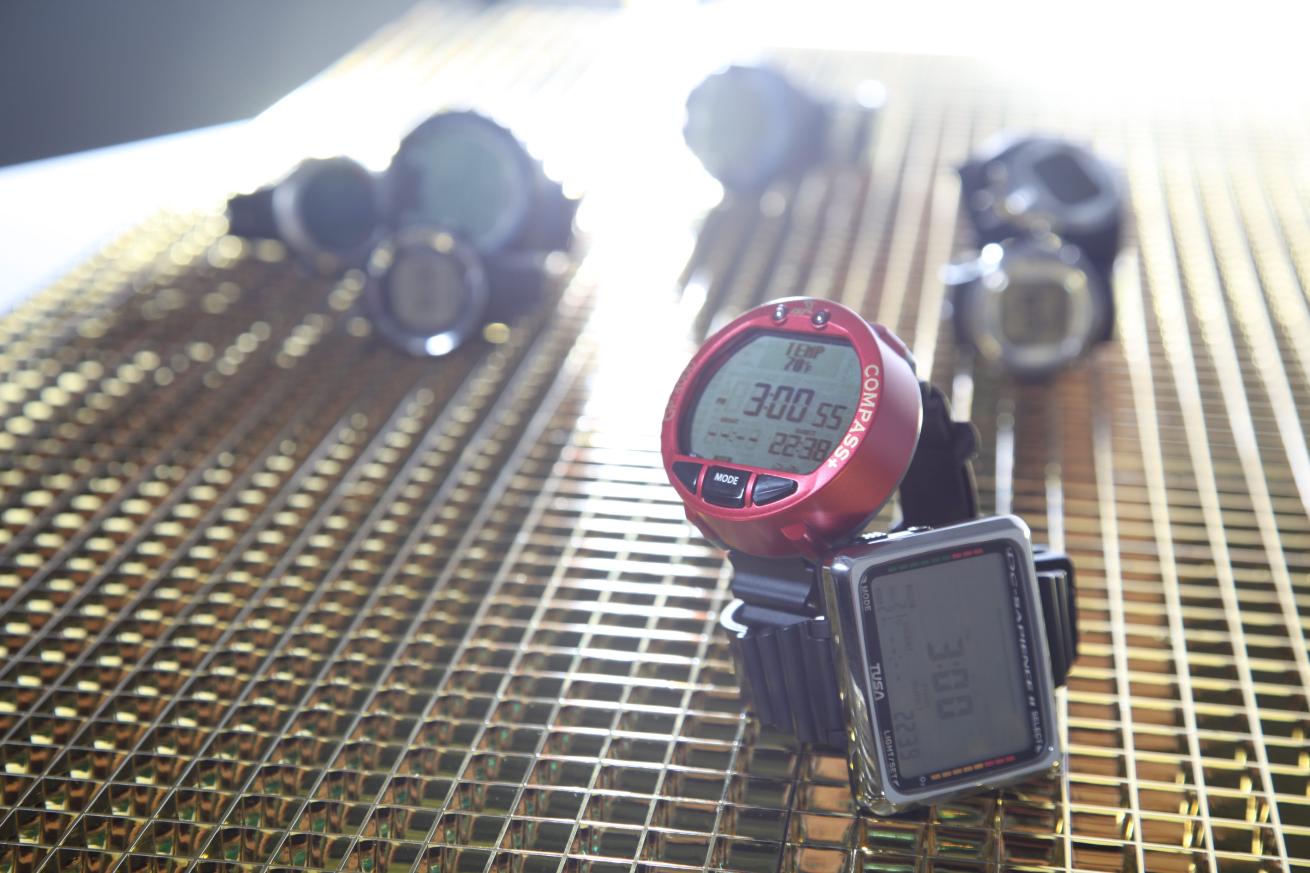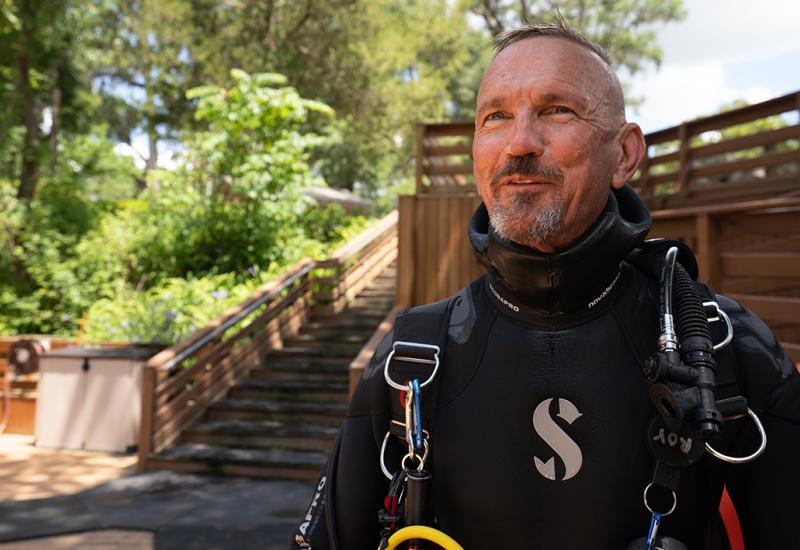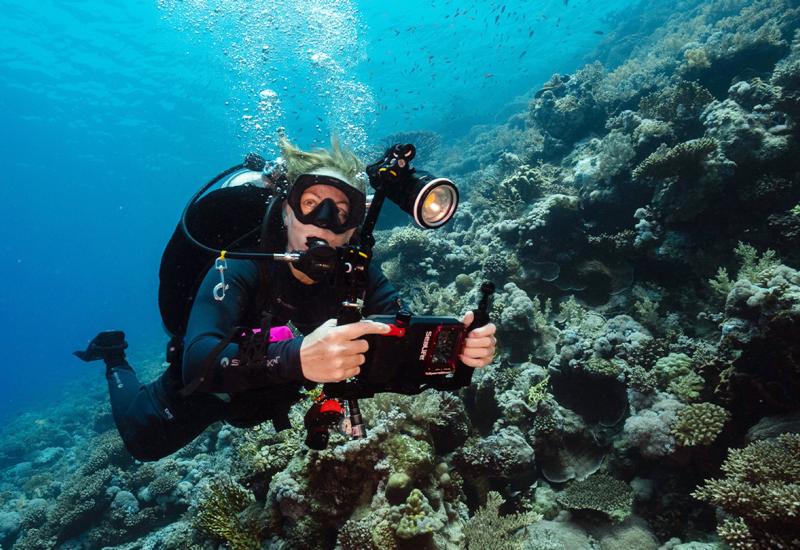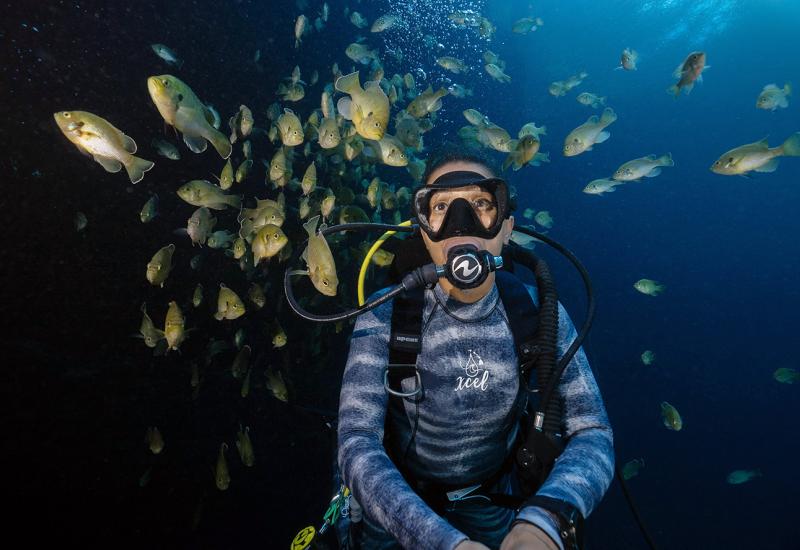ScubaLab: Dive Computer Tests 2011

2011 dive computer test opener
Carrie Garcia
2011 Dive Computer Tests
By Floyd G. Devine, Test Team Supervisor
Photographs by Carrie Garcia and Courtney Michalik
For the individual scuba gear reviews of the 2011 dive computers, see the “Related Articles” at the bottom of the page.
For tips on caring for dive computers, visit Tips for Dive Computer Maintenance.
While dive computers have been available for the past 20 years, they have really come into their own during the past decade. This year’s crop of new and redesigned dive computers represents incremental changes to form and technology rather than the giant leaps forward sometimes made in the past. This is not entirely unexpected given the overall industry trend to level prices. The upside for divers: More features in familiar forms without a significant change in price.
General Observations
Today, divers can choose from a variety of dive computers, from affordable units that provide all the basic dive information, including nitrox capability to high-end systems offering features such as digital compasses, color screens and air-integration systems with remote transmitters or quick disconnect couplings to a regulator’s high-pressure hose. Not only have features advanced within the past decade, the consumer can also choose from full-function wristwatch-size computers to large-screen consoles that can be easily read under any condition. 
The biggest benefit to divers offered by the availability, reliability and advanced technology of today’s dive computers is increased safety. Even the most basic systems monitor depths, dive times, no-decompression limits, ascent rates and nitrogen loading, and will warn you both visually and through user-adjustable audible alarms when you push the edge of the recreational-dive envelope. Many rec divers have forgotten how to use dive tables, sometimes placing themselves at risk when they participate in multiday/multidive trips. With a modern dive computer, you can vary the dive profile on the fly and stay within acceptable limits for no-decompression diving as the computer accounts for nitrogen loading from previous dives and your programmable personal factors, all of which makes your diving safer and less stressful.
Testing Procedures
To evaluate this year’s group of dive computers, ScubaLab used a three-phase testing procedure that included evaluation in our Winter Park, Florida, offices, hyperbaric testing at USC’s Wrigley Marine Science Center in Catalina, California, and in-water testing at one of Central Florida’s numerous freshwater springs.
Lab Evaluation: Owner’s manuals and “quick-reference cards” are reviewed. This material is evaluated on its simplicity and usefulness, and the availability of PC connectivity cables and software is noted. The available documentation ranged from easy-to-understand manuals and quick reference cards to lengthy, confusing manuals that are unlikely to be read completely by most users. Each computer is then unpacked and the various user-adjustable settings are programmed for use in our objective testing.
To see the dive computers features chart, click here
Objective Testing: Our objective test procedure is principally designed to determine the liberal or conservative leanings of the dive computers, and secondarily, to verify the accuracy of the computer’s critical information displays, such as depth and bottom time. For the testing, dive computers are set on their most liberal air dive settings, submerged in a shallow tank inside the hyperbaric chamber and pressurized during four dives, with appropriate surface intervals, simulating a full day on a live-aboard dive trip.
Conservative/Liberal Tendencies: This is the probably the most debated aspect of a dive computer’s function. Many divers will pass up an advanced dive computer with lots of bells and whistles for one they feel will “give them more bottom time.” Our hyperbaric testing revealed that computers do have a tendency to be more liberal or conservative, based on their particular no-decompression model, but the results were rarely “across the board” and most computers fall into what could be considered an “average” range with one or two profiles being more or less conservative.
Accuracy of Critical Information: As expected of modern-day computer systems, there were no notable discrepancies between the displayed depth and timing functions of the tested computers and the calibrated systems of the hyperbaric facility. For the consumer, this means accuracy of the dive computer’s information would not be a significant factor in choosing a system, allowing a diver to focus on styling, information display and features when making his or her selection.
To see the results of the hyperbaric chamber testing, click here.
Ergonomic Testing: For the ergonomic testing, our team of five divers, two photographers and one supervisor spent a day in Williston, Florida, diving at Blue Grotto Spring. Blue Grotto provided an excellent location to test computers: It has easy access to the spring during multiple entry and exits, moderate depths and full-service dive shop on site. Once again, the computers were put through four dives. To make the testing more “real-world,” the divers were only provided quick-reference cards for the computers. Divers rated each computer in seven areas of performance on a 1-to-5 scale and recorded specific observations and comments following each dive.
1. Ease of Navigating the System/Setting Parameters: Before and between dives, how easy is it to prepare the computer for use (change O2percent, PO2 or other information necessary to the planned dive), use the dive planner and access logbook data?
2. Ease of Reading/Understanding Primary Screen: Is the display clear and easy to see and read? Is the primary screen easy to understand at a glance?
3. Ease of Discerning Critical Data (Depth/NDLs/BT): Can critical data be quickly determined: Depth, No-Decompression Limits, Bottom Time, Ascent Rate and Safety Stop? If the unit is air integrated, is it easy to read tank pressure?
4. Ease of Accessing Alternate Screen Data: How easy is it to switch to alternate screens or change secondary display items?
**
5. Ease of Discerning Noncritical Data (Temp, Time, etc.):** Without spending too much time or becoming distracted from monitoring safety or other practical  considerations of the dive, can you easily read noncritical data: Time, Water Temp, Max Depth, N2 or O2 loading, digital compass or other features unique to the computer?
considerations of the dive, can you easily read noncritical data: Time, Water Temp, Max Depth, N2 or O2 loading, digital compass or other features unique to the computer?
6. Effectiveness of Backlight/Illumination: How well does the backlight work? Is it bright enough to clearly read the display in low light situations?
7. Ease of Accessing Surface Interval Data: After the dive, does the computer clearly display surface interval time and no-fly indications?
To see the results of the ergonomic testing, click here.
Final Observations
When all of the evaluations and testing were completed, one thing was apparent: All the computers performed nearly equally well in their combined scores and, when used properly, any of them would enhance your dive and improve your overall safety. Each computer had specific areas that scored higher or lower than others, but the differences were fractional and none of the systems received significant criticism in any area of evaluation. As with the objective testing, the ergonomic testing results indicate that the consumer’s choice of computer comes down to personal preference in price, form factor, display appearance and size, features and the slightly muddled issue of conservatism of the system.
The Test Team
A special thanks to Karl Huggins, Director of the USC Catalina Hyperbaric Chamber, and his chamber crew for their professional conduct of the objective tests at USC’s Wrigley Marine Science Center on Catalina Island, Calif.
Blue Grotto Test Team: Adam Lytle, Evan Culbertson, Floyd Devine (Supervisor), John Conley, Joshua Graham, Walter Fronsdahl, Katy Danca Galli and Courtney Michalik.

Carrie Garcia
2011 Dive Computer Tests
By Floyd G. Devine, Test Team Supervisor
Photographs by Carrie Garcia and Courtney Michalik
For the individual scuba gear reviews of the 2011 dive computers, see the “Related Articles” at the bottom of the page.
For tips on caring for dive computers, visit Tips for Dive Computer Maintenance.
While dive computers have been available for the past 20 years, they have really come into their own during the past decade. This year’s crop of new and redesigned dive computers represents incremental changes to form and technology rather than the giant leaps forward sometimes made in the past. This is not entirely unexpected given the overall industry trend to level prices. The upside for divers: More features in familiar forms without a significant change in price.
General Observations
Today, divers can choose from a variety of dive computers, from affordable units that provide all the basic dive information, including nitrox capability to high-end systems offering features such as digital compasses, color screens and air-integration systems with remote transmitters or quick disconnect couplings to a regulator’s high-pressure hose. Not only have features advanced within the past decade, the consumer can also choose from full-function wristwatch-size computers to large-screen consoles that can be easily read under any condition. 
The biggest benefit to divers offered by the availability, reliability and advanced technology of today’s dive computers is increased safety. Even the most basic systems monitor depths, dive times, no-decompression limits, ascent rates and nitrogen loading, and will warn you both visually and through user-adjustable audible alarms when you push the edge of the recreational-dive envelope. Many rec divers have forgotten how to use dive tables, sometimes placing themselves at risk when they participate in multiday/multidive trips. With a modern dive computer, you can vary the dive profile on the fly and stay within acceptable limits for no-decompression diving as the computer accounts for nitrogen loading from previous dives and your programmable personal factors, all of which makes your diving safer and less stressful.
Testing Procedures
To evaluate this year’s group of dive computers, ScubaLab used a three-phase testing procedure that included evaluation in our Winter Park, Florida, offices, hyperbaric testing at USC’s Wrigley Marine Science Center in Catalina, California, and in-water testing at one of Central Florida’s numerous freshwater springs.
Lab Evaluation: Owner’s manuals and “quick-reference cards” are reviewed. This material is evaluated on its simplicity and usefulness, and the availability of PC connectivity cables and software is noted. The available documentation ranged from easy-to-understand manuals and quick reference cards to lengthy, confusing manuals that are unlikely to be read completely by most users. Each computer is then unpacked and the various user-adjustable settings are programmed for use in our objective testing.
To see the dive computers features chart, click here
Objective Testing: Our objective test procedure is principally designed to determine the liberal or conservative leanings of the dive computers, and secondarily, to verify the accuracy of the computer’s critical information displays, such as depth and bottom time. For the testing, dive computers are set on their most liberal air dive settings, submerged in a shallow tank inside the hyperbaric chamber and pressurized during four dives, with appropriate surface intervals, simulating a full day on a live-aboard dive trip.
Conservative/Liberal Tendencies: This is the probably the most debated aspect of a dive computer’s function. Many divers will pass up an advanced dive computer with lots of bells and whistles for one they feel will “give them more bottom time.” Our hyperbaric testing revealed that computers do have a tendency to be more liberal or conservative, based on their particular no-decompression model, but the results were rarely “across the board” and most computers fall into what could be considered an “average” range with one or two profiles being more or less conservative.
Accuracy of Critical Information: As expected of modern-day computer systems, there were no notable discrepancies between the displayed depth and timing functions of the tested computers and the calibrated systems of the hyperbaric facility. For the consumer, this means accuracy of the dive computer’s information would not be a significant factor in choosing a system, allowing a diver to focus on styling, information display and features when making his or her selection.
To see the results of the hyperbaric chamber testing, click here.
Ergonomic Testing: For the ergonomic testing, our team of five divers, two photographers and one supervisor spent a day in Williston, Florida, diving at Blue Grotto Spring. Blue Grotto provided an excellent location to test computers: It has easy access to the spring during multiple entry and exits, moderate depths and full-service dive shop on site. Once again, the computers were put through four dives. To make the testing more “real-world,” the divers were only provided quick-reference cards for the computers. Divers rated each computer in seven areas of performance on a 1-to-5 scale and recorded specific observations and comments following each dive.
1. Ease of Navigating the System/Setting Parameters: Before and between dives, how easy is it to prepare the computer for use (change O2percent, PO2 or other information necessary to the planned dive), use the dive planner and access logbook data?
2. Ease of Reading/Understanding Primary Screen: Is the display clear and easy to see and read? Is the primary screen easy to understand at a glance?
3. Ease of Discerning Critical Data (Depth/NDLs/BT): Can critical data be quickly determined: Depth, No-Decompression Limits, Bottom Time, Ascent Rate and Safety Stop? If the unit is air integrated, is it easy to read tank pressure?
4. Ease of Accessing Alternate Screen Data: How easy is it to switch to alternate screens or change secondary display items?
**
5. Ease of Discerning Noncritical Data (Temp, Time, etc.):** Without spending too much time or becoming distracted from monitoring safety or other practical  considerations of the dive, can you easily read noncritical data: Time, Water Temp, Max Depth, N2 or O2 loading, digital compass or other features unique to the computer?
considerations of the dive, can you easily read noncritical data: Time, Water Temp, Max Depth, N2 or O2 loading, digital compass or other features unique to the computer?
6. Effectiveness of Backlight/Illumination: How well does the backlight work? Is it bright enough to clearly read the display in low light situations?
7. Ease of Accessing Surface Interval Data: After the dive, does the computer clearly display surface interval time and no-fly indications?
To see the results of the ergonomic testing, click here.
Final Observations
When all of the evaluations and testing were completed, one thing was apparent: All the computers performed nearly equally well in their combined scores and, when used properly, any of them would enhance your dive and improve your overall safety. Each computer had specific areas that scored higher or lower than others, but the differences were fractional and none of the systems received significant criticism in any area of evaluation. As with the objective testing, the ergonomic testing results indicate that the consumer’s choice of computer comes down to personal preference in price, form factor, display appearance and size, features and the slightly muddled issue of conservatism of the system.
The Test Team
A special thanks to Karl Huggins, Director of the USC Catalina Hyperbaric Chamber, and his chamber crew for their professional conduct of the objective tests at USC’s Wrigley Marine Science Center on Catalina Island, Calif.
Blue Grotto Test Team: Adam Lytle, Evan Culbertson, Floyd Devine (Supervisor), John Conley, Joshua Graham, Walter Fronsdahl, Katy Danca Galli and Courtney Michalik.










